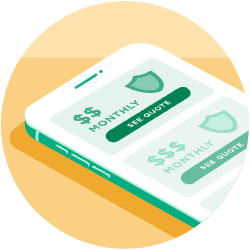Product Liability Insurance: What It Covers, Who Needs It
Product liability insurance can help protect businesses involved in the distribution and sale of goods.

Many, or all, of the products featured on this page are from our advertising partners who compensate us when you take certain actions on our website or click to take an action on their website. However, this does not influence our evaluations. Our opinions are our own. Here is a list of our partners and here's how we make money.
Product liability insurance helps protect businesses if they are accused of making, distributing or repairing a product that causes harm. Some product liability coverage is typically included in a general liability insurance policy, but businesses facing greater risks may need to increase their limits or purchase additional coverage.
Here's what this kind of business insurance covers, how much it costs and how to evaluate quotes and select a policy that's right for your business.

Save up to 25% on business insurance
NerdWallet Small Business offers General Liability coverage starting at $19/month, with free tailored quotes in just a few minutes through our partner, NEXT.via NEXT
What is product liability insurance?
Product liability insurance helps protect a business when there’s a claim that a product it made or sold caused harm. Claims of physical injury or property damage can be brought by the buyer of the product, a user of the product or a bystander.
The physical harm or damage caused by the product can be the result of the following:
Design flaws.
Product defects.
Inadequate instructions, labels and warnings.
Just about any product has the potential to cause harm or property damage. For example, food sold at a restaurant could make someone sick. A small toy not labeled correctly could be a choking hazard. A computer purchased online might overheat and cause damage. A mower repaired at a local shop could malfunction and injure the user.
What types of businesses need product liability insurance?
Product liability insurance is not legally required, but a business that does any of the following product-related activities should consider purchasing it:
Manufacturing.
Distributing.
Wholesaling.
Importing.
Retailing.
Installing.
Repairing/modifying.

Save up to 25% on business insurance
NerdWallet Small Business offers General Liability coverage starting at $19/month, with free tailored quotes in just a few minutes through our partner, NEXT.via NEXT
How much does product liability insurance cost?
The average annual cost for product liability insurance is about $1,200 for small businesses in the manufacturing, retail and wholesale industries with revenue of less than $1 million, according to an analysis of rate quotes by AdvisorSmith, a website that reviews small-business insurance and other products.
However, the cost of business insurance varies widely. How much you will pay for product liability insurance will depend on the risk level associated with your business.
Some factors that may influence your premium amount include the following:
Type of product. Products that are more likely to result in harm to the consumer if defective, such as food items, result in higher rates.
Sales. The higher your sales, the more you'll pay for insurance.
Position in supply chain. Manufacturers pay higher rates than distributors.
Coverage limits. More coverage comes with higher premiums.
Claim history. Previous claims will increase rates.
What costs does product liability insurance cover?
Product liability insurance would typically help with the following costs associated with an injury or property damage claim:
Your legal fees.
Settlements and court-ordered judgments paid to the injured party.
Medical bills of the injured party.
What costs aren't covered by product liability insurance?
The following would not be covered by product liability insurance:
Recall costs and inventory losses. To cover the costs associated with a recall, product recall insurance can be purchased.
Employee injuries. Workers’ compensation insurance will generally cover employees who are injured or become ill at work.
Customer injuries on a business property. General liability insurance would help cover the medical expenses of a non-employee injured at your business.
How can I get product liability insurance?
If you already have general liability insurance, some product liability protection is included in your coverage. A commercial general liability insurance policy protects business owners if one of their products or completed projects is accused of causing harm to someone later.
But if your product liability risks are significant, you should consider buying additional product liability insurance coverage. You may also need separate coverages, like product recall insurance, to cover other product-related risks.
A licensed commercial insurance agent can help you find insurance for your business. You can shop online and get a quote. Or, you can call an insurance company and talk to a representative.
There are many commercial insurance companies that can provide product liability coverage. To help you make coverage and pricing comparisons, you’ll want to get quotes from a number of different insurers. Consider starting with the following:
If you don’t already have a general liability insurance policy: The Hartford and Allstate both specify that their general liability insurance policies include some product liability coverage. That’s the case with most insurers, but if you’re concerned about product liability risks, make sure to confirm that your policy includes products-completed operations coverage.
If you need additional coverage, like product recall insurance: Look for an insurance company like Travelers, which offers packages designed for specific industries. These can make it easier to shop for insurance coverage tailored to your needs.
If you want robust product risk management services: Chubb offers product recall insurance, as well as a long list of educational programs for its clients, including seminars on product liability laws; product user guides and instruction manuals; product warnings and labels; and more.
» MORE: How to get business insurance
What are the product liability coverage limits?
The insurance company will often recommend coverage limits based on your business and may give you the option to select a deductible amount. A policy typically has an occurrence limit and an aggregate limit. The occurrence limit is the maximum amount the insurer will pay per claim. The aggregate limit is the maximum amount the insurer will pay in total for multiple claims during the policy period.
For example, a business may have a policy of $1 million per occurrence, $2 million per aggregate. A claim of $1 million or less would be paid by the insurance company, minus any required deductible. Any amount over the $1 million would be the responsibility of the business. If multiple claims are filed during the policy period, the total amount the insurer would cover is $2 million. Any amount over that would be paid by the business.
If your business uses retailers to sell your products, the coverage limits you select for your policy would also need to meet their requirements.
How do I evaluate product liability insurance quotes?
You can expect every insurance quote you receive to be slightly different, but it’s easier to compare quotes if they have similar coverage limits and deductible amounts. A review of the following areas can help you evaluate the quotes:
Price
Quotes that are slightly over budget may still have potential, but ones that fall well outside your budget may need to be set aside.
Coverage limits
The coverage limits may vary between the quotes, but they should be similar if you provided the same information during the quote process. A higher coverage limit is generally better, unless the cost is not affordable.
Deductibles
A higher deductible can reduce your insurance premium, but your business will be responsible for this amount if a claim is filed. Select an amount that won’t put your business in a financial bind if it becomes necessary to pay the deductible.
Ratings
When purchasing insurance, it’s important that the company issuing the policy has the financial ability to pay claims. Five independent agencies provide ratings on the financial strength of insurance companies, according to the Insurance Information Institute; these are A.M. Best, Fitch, Kroll Bond Rating Agency (or KBRA), Moody’s and Standard & Poor’s (or S&P). These agencies have different rating scales and may not always agree, but you can arrive at prevailing opinions by comparing a few ratings.
Tips for getting product liability insurance
Get multiple quotes
The cost of product liability insurance can vary significantly. The best way to know if you are getting a good deal is to shop around and review at least three quotes.
Consider a BOP
Business owner’s policies typically combine general liability, commercial property and business interruption coverage into a single policy that can be less expensive than individual policies.
Balance the cost vs. value
Carefully weigh the coverage a policy provides against the costs. A cheap policy may be tempting, but not having the protection you need when facing a claim can be costly to your business.

